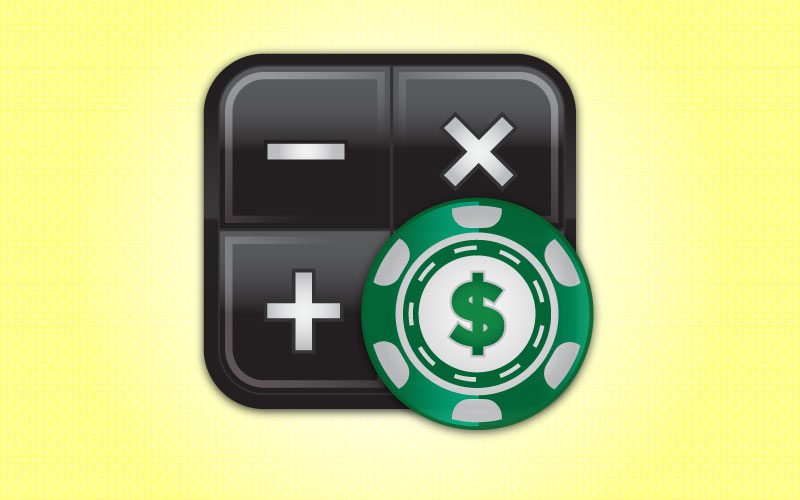Over the past three weeks, we have been building up to this week’s material. This week, we’re going to look at how to use what we’ve learned so far to perform EV calculations for extremely complicated scenarios. The math involved does not change at all whenever these scenarios get more complicated. However, being able to organize these scenarios effectively and check your answers is a major skill involved, and it’s going to use very careful applications of the subjects that we have looked at over the past three weeks.
A Difficult Scenario
We’re going to evaluate the EV of a particular strategy for a specific hand in the following situation. We are heads-up and out of position on the turn in a no-limit hold’em cash game hand. We hold JsTs on a board of As4h5d9s. The pot is currently $28 with $81 in our stack, and our opponent barely has us covered. We bet $21 on the turn. If our opponent raises us on the turn, then we fold our hand. Our opponent raises us 20 percent of the time, and our opponent folds 20 percent of the time.
The other 60 percent of the time, our opponent calls. There are nine spades left in the deck with 46 cards left to come, so the chance of a spade coming is 9/46. If a spade does not come, then we always check/fold with no chance of winning the pot even if it checks through. If a spade does come, then we go all-in for our last $60 on the river. Our opponent will fold 60 percent of the time. A total of 45 percent of the time, we will be called and win, but 5 percent of the time, we will be called and lose.
The Process of Organization
This is a much more complicated scenario than anything that we have looked at so far before. However, the math part of it is particularly easy to do if you have followed through the previous three installments of this series. The hardest part is organizing your answers. The first thing we have to do, like always, is make a list of all of the possible outcomes of this scenario.
- We bet on the turn, our opponent folds.
- We bet on the turn, our opponent raises, we fold.
- We bet on the turn, our opponent calls, a non-spade comes on the river, we check/fold.
- We bet on the turn, our opponent calls, a spade comes on the river, we bet, our opponent folds.
- We bet on the turn, our opponent calls, a spade comes on the river, we bet, our opponent calls, we win at showdown.
- We bet on the turn, our opponent calls, a spade comes on the river, we bet, our opponent calls, we lose at showdown.
There are six different outcomes for this scenario. We need to find the EV for each of these scenarios by finding the chance that they happen and our profit when they happen. I’m going to address each scenario one at a time.
Outcome 1
Our opponent folds 20 percent of the time, and we win the pot of $28 when he folds. This makes the EV of this outcome (0.20)($28) = $5.60.
Outcome 2
Our opponent raises 20 percent of the time, and we lose our $21 turn bet when this happens. This makes the EV of this outcome (0.20)(-$21) = -$4.20.
Outcome 3
Our opponent calls the turn 60 percent of the time and a non-spade comes (37/46) of the time. We check/fold which loses our turn bet of $21. To find the chance of this outcome happening, we multiply (0.60)(37/46) like we did in part 3 of this series. We then multiply that chance by our profit in this outcome of -$21 to get our EV which is (0.60)(37/46)(-$21) = -$10.13.
Outcome 4
We are called on the turn 60 percent of the time. A spade comes on the turn (9/46) of the time. Our opponent folds to our river bet 50 percent of the time. The chance of this outcome happening is (0.60)(9/46)(0.50). Our profit will be the turn pot of $28 plus the turn bet that our opponent called worth $21 for a total profit of $49. That means that the EV of this outcome is (0.60)(9/46)(0.50)($49) = $2.88.
Outcome 5
Again, we’re called on the turn 60 percent, a spade comes (9/46) of the time, and we’re called in a situation where we win at showdown 45 percent of the time. That makes the chance of this outcome occurring (0.60)(9/46)(0.45). Our profit in this scenario is the $28 turn pot plus the $21 turn bet that our opponent calls plus the $60 river bet that our opponent calls for a total of $109. So our EV for the fifth possible outcome is (0.60)(9/46)(0.45)($109) = $5.76.
Outcome 6
Same Bat time. Same Bat channel. Our chance of this outcome happening is (0.60)(9/46)(0.05). Our profit is found by combining the bet we lose on the turn ($21) plus the bet we lose on the river ($60) to get a profit of -$81. Our EV in the sixth outcome is (0.60)(9/46)(0.05)(-$81) = -$0.48.
Checking Our Percentages
In complicated situations, we should check our percentages to make sure that we have all of the scenarios covered correctly. Here are the chances of each outcome:
- Outcome 1: 20%
- Outcome 2: 20%
- Outcome 3: (0.60)(37/46) = 48.26%
- Outcome 4: (0.60)(9/46)(0.50) = 5.87%
- Outcome 5: (0.60)(9/46)(0.45) = 5.28%
- Outcome 6: (0.60)(9/46)(0.05) = 0.59%
And those six outcomes add up to give us 100% which tells us that we have covered all of the outcomes correctly.
Finding the Total Value
All that’s left at this point is to add up all of the six individual expected values to give us the overall expected value of the scenario. As it turns out, our EV of this scenario is -$0.57.
The goal of this series was to show you how to do complicated expected value situations. Now you can use this calculations to try to model scenarios that come up in your hands to try to figure out which strategic options and plans have the best overall expected value.
Submit your review | |








